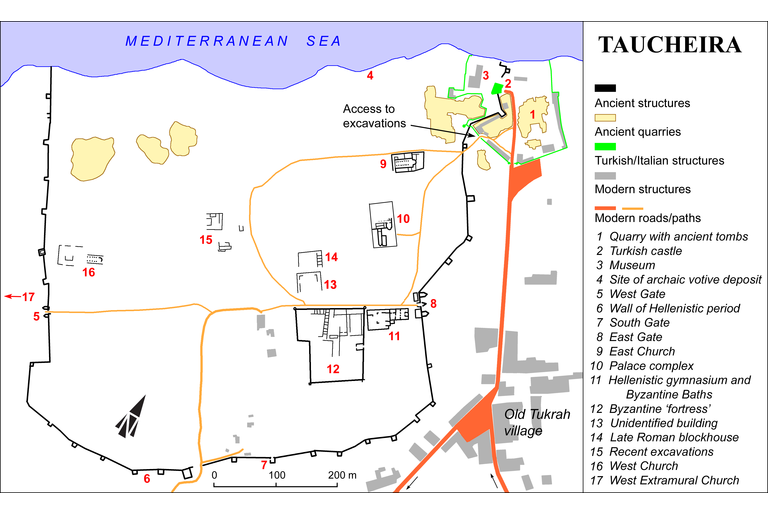Pederastic acclamation
IGCyr004310
Trismegistos ID: 738148
Source Description
Support
Fragmentary black-glazed ware dish decorated with palmettes (diameter maximum 0.14).
Layout
Scratched a) on upper right; b) at left; c) beneath, at break.
Place of Origin
Findspot.
Date
350-320 B.C. (monument-type)
Findspot
Found in 1963 at Taucheira pleiades; HGL strewn on the archaic votive deposit .
Last recorded Location
Seen by J. Boardman in 1965.
Present Location
Not seen by IGCyr team.
Text constituted from
Transcription from previous editor (CDL).
Bibliography
Boardman-Hayes, 1973 Boardman, J., Hayes, J., 1973, Excavations at Tocra 1963-1965. The archaic deposits II and later deposits, British School of Archaeology at AthensSuppl. 10, London - see in bibliography , pp. 102-103, n. 2360 (dr.); Dobias-Lalou, 2015 Dobias-Lalou, C., 2015, Les débuts de l'écriture en Cyrénaïque, in A. Inglese, Epigrammata 3. Saper scrivere nel Mediterraneo antico. Esiti di scrittura fra VI e IV sec. a.C., in ricordo di Mario Luni. Atti del convegno di Roma, 7-8 Novembre 2014, Tivoli, 59-80, 315-321 - see in bibliography , p. 68 with footnote 42.
Apparatus
a.1 Dobias-Lalou, 2015 Dobias-Lalou, C., 2015, Les débuts de l'écriture en Cyrénaïque, in A. Inglese, Epigrammata 3. Saper scrivere nel Mediterraneo antico. Esiti di scrittura fra VI e IV sec. a.C., in ricordo di Mario Luni. Atti del convegno di Roma, 7-8 Novembre 2014, Tivoli, 59-80, 315-321 - see in bibliography Σίτ⸢αρ⸣ lapis: ραχ{σ}ος : Boardman-Hayes, 1973 Boardman, J., Hayes, J., 1973, Excavations at Tocra 1963-1965. The archaic deposits II and later deposits, British School of Archaeology at AthensSuppl. 10, London - see in bibliography Σιτραχος : Boardman-Hayes, 1973 Boardman, J., Hayes, J., 1973, Excavations at Tocra 1963-1965. The archaic deposits II and later deposits, British School of Archaeology at AthensSuppl. 10, London - see in bibliography Σιτραξος (Boardman)
French translation
a) Sitarkhos, un vagin, une verge.
b) et c) intraduisibles.
English translation
a) Sitarchos, a vagina, a penis.
b) and c) not usefully translatable.
Italian translation
a) Sitarchos, una vagina, un pene.
b) e c) intraducibili.
Commentary
Boardman rightly interpreted a) as a pederastic graffito, although puzzled by the proper name at the beginning. As for its reading, a sigma is written above chi and was probably intended to replace the other one, written at end of the name, but conflicting with the kappa of κύσθος. Evidently, a lettering ΧΣ for ξ should be anachronistic, both in consideration of the date of the ceramics and beside a psi.
If inverting two letters, we get the personal name Σίταρχος, which is already attested at Eretria.
Creative Commons Attributions-NonCommercial 4.0 International License.
All citation, reuse or distribution of this work must contain a link back to DOI: http://doi.org/10.6092/UNIBO/IGCYRGVCYR and the filename (IGCyr000000 or GVCyr000), as well as the year of consultation.
